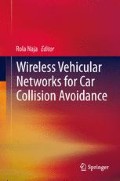Abstract
The provision of reliable data transmission and low-latency wireless communications is challenging for the network operator due to the characteristics (high mobility) of the vehicle and several factors like quality of service requirements of real-time traffic.
Access this chapter
Tax calculation will be finalised at checkout
Purchases are for personal use only
References
Institute of Electrical and Electronics Engineers (2007) IEEE standard for information technology—telecommunications and information exchange between systems—local and metropolitan area networks—specific requirements part 11: wireless LAN medium access control (MAC) and physical layer (PHY) specifications
Institute of Electrical and Electronics Engineers (2010). IEEE standard for information technology-telecommunications and information exchange between systems-local and metropolitan area networks- specific requirements. Part11: wireless LAN medium access control (MAC) and physical layer (PHY) specifications- amendment 6: wireless access in vehicular environments (WAVE)
Shukla D, Chandran-Wadia L, Iyer S (2003) Mitigating the exposed node problem in IEEE 802.11 ad hoc networks. In: Proceedings of IEEE international conference on computer communications and networks ICCCN, pp 157–162, doi: 10.1109/ICCCN.2003.1284164
Institute of Electrical and Electronics Engineers Vehicular Technology Society (2006) IEEE 1609.4 draft standard for wireless access in vehicular environments (WAVE)—multi-channel operation
Lin W, Li M, Lan K, Hsu C (2011) A comparison of 802.11a and 802.11p for V-to-I communication: a measurement study, QShine 2010, Springer LNICST 74, pp 559–570
ETSI EN 302665 (2010) Intelligent transport systems (ITS); communications architecture
ETSI ES 202663 (2010) Intelligent transport systems (ITS); European profile standard for the physical and medium access control layer of intelligent transport systems operating in the 5 GHz frequency band
ETSI TS 102 687 (V1.1.1) (2011) Intelligent transport systems (ITS); decentralized congestion control mechanisms for intelligent transportation systems operating in the 5 GHz range; access layer part
ETSI TS 102 637-2 (V1.2.1) (2011) Intelligent transport systems (ITS); vehicular communications; basic set of applications; part 2: specification of cooperative awareness basic service
ETSI TS 102 637-3 (V1.1.1) (2010) Intelligent transport systems (ITS); vehicular communications; basic set of applications; part 3: specification of decentralized environmental notification basic service
Stanica R, Chaput E, Beylot A.-L. (2012) Loss reasons in safety VANETs and implications on congestion. In: Proceedings of ACM international symposium on performance evaluation of wireless ad hoc, sensor and ubiquitous networks PE-WASUN, pp 1–8, doi: 10.1145/2387027.2387029
Bai F, Stancil D, Krishnan H (2010) Toward understanding characteristics of dedicated short range communications (DSRC) from a perspective of vehicular network engineers. In: Proceedings of ACM international conference on mobile computing and networking MobiCom, pp 329–340, doi: 10.1145/1859995.1860033
Ramachandran K, Gruteser M, Onishi R, Hikita T (2007) Experimental analysis of broadcast reliability in dense vehicular networks. IEEE Veh Technol Mag 2(4):26–32
Fukui R, Koike H, Okada H (2002) Dynamic integrated transmission control (DITRAC) over inter-vehicle communications in ITS. In: Proceedings of IEEE vehicular technology conference VTC spring 2002, pp 438–487, doi: 10.1109/VTC.2002.1002762
Rezaei S, Sengupta R, Krishnan H (2007) Reducing the communication required by DSRC-based vehicle safety systems. In: Proceedings of IEEE intelligent transportation systems conference ITSC 2007, pp 361–366, doi: 10.1109/ITSC.2007.4357633
Wong S, Yang H, Lu S, Bharghavan V (2006) Robust rate adaptation for 802.11 wireless networks. In: Proceedings of ACM international conference on mobile computing and networking MobiCom 2006, pp 146–157, doi: 10.1145/1161089.116.1107
Holland G, Vaidya N, Bahl P (2001) A rate-adaptive mac protocol for multi-hop wireless networks. In: Proceedings of ACM international conference on mobile computing and networking MobiCom 2001, pp 236–251, doi: 10.1145/381677.381700
Ruffini M, Reumerman H-J (2005) Power-rate adaptation in high-mobility distributed ad-hoc wireless networks. In: Proceedings of IEEE vehicular technology conference VTC spring 2005, vol 4, pp 2299–2303, doi: 10.1109/VETECS.2005.1543745
Huang C, Fallah Y, Sengupta R, Krishnan H (2010) Adaptive intervehicle communication control for cooperative safety systems. IEEE Netw 24(1):6–13, doi: 10.1109/MNET.2010.5395777
Guan X, Sengupta R, Krishnan H, Bai F (2007) A feedback-based power control algorithm design for VANET. In: Proceedings of IEEE mobile networking for vehicular environments MOVE 2007, pp 67–72, doi: 10.1109/MOVE.2007.4300806
Stanica R, Chaput E, Beylot A-L (2011) Why VANET beaconing is more than simple broadcast. In: Proceedings of IEEE vehicular technology conference VTC Fall 2011, pp 1–5, doi: 10.1109/VETECF.2011.6093233
Mertens Y, Wellens M, Mahonen P (2008) Simulation-based performance evaluation of enhanced broadcast schemes for IEEE 802.11-based vehicular networks. In: Proceedings of IEEE vehicular technology conference VTC Spring 2008, pp 3042–3046, doi: 10.1109/VETECS.2008.328
Stanica R, Chaput E, Beylot A-L (2011) Physical carrier sensing in vehicular ad-hoc networks. In: Proceedings of IEEE international conference on mobile ad hoc and sensor systems MASS 2011, pp 580–589, doi: 10.1109/MASS.2011.61
Author information
Authors and Affiliations
Corresponding author
Editor information
Editors and Affiliations
Rights and permissions
Copyright information
© 2013 Springer Science+Business Media New York
About this chapter
Cite this chapter
Naja, R., Stanica, R. (2013). Quality of Service Provisioning in Wireless Vehicular Networks: Challenges and Mechanisms. In: Naja, R. (eds) Wireless Vehicular Networks for Car Collision Avoidance. Springer, New York, NY. https://doi.org/10.1007/978-1-4419-9563-6_2
Download citation
DOI: https://doi.org/10.1007/978-1-4419-9563-6_2
Published:
Publisher Name: Springer, New York, NY
Print ISBN: 978-1-4419-9562-9
Online ISBN: 978-1-4419-9563-6
eBook Packages: EngineeringEngineering (R0)

